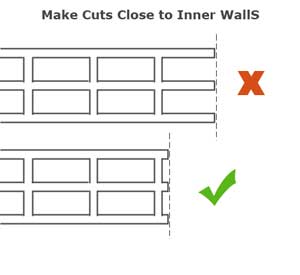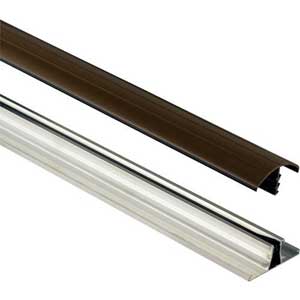Polycarbonate Roofing Sheets are mainly used on conservatories, but this highly durable material can also be used for glazing greenhouses, porch windows and much more. Polycarbonate is one of the strongest plastics available and the triple walled type is increasingly being used as a replacement for wired safety glass.
Polycarbonate has a natural tendency to expand and contract so it is fitted ‘loose’ in special glazing bars. This clip-in fixing method means that fitting it is often much quicker than traditional glazing, whilst resulting in a much nicer and more durable finish than traditional corrugated plastic sheets.
Properties of Polycarbonate Sheets
– Up to 200 times stronger than glass
– 5 times lighter than glass
– Shatterproof
– Flexible
– Transmits up to 90% of available light
– Built-in UV protection as standard
– Adds insulation
– Dual, triple or even five-walled types available
Cutting and Preparing Polycarbonate Sheet
 Despite its impressive strength, Polycarbonate roof sheets can be cut easily using a fine toothed saw (such as a panel saw). Apart from making careful measurements before you make any cuts, the main thing to remember is to always try to cut as close to one of the inner walls as possible. This will help to maintain the strength of the cut end.
Despite its impressive strength, Polycarbonate roof sheets can be cut easily using a fine toothed saw (such as a panel saw). Apart from making careful measurements before you make any cuts, the main thing to remember is to always try to cut as close to one of the inner walls as possible. This will help to maintain the strength of the cut end.
It is also important to leave the protective polythene covering in place until you are ready to actually fit the sheet. The top and bottom end of the sheet will be capped when the sheet is whole. If you have to trim the sheet, try to make sure that the top end capping remains. The cut end should then be capped with breather tape (perforated self-adhesive tape, sometimes supplied with the roof sheets). A plastic cover bead can then be fitted over the tape to cap the end.
It is important to keep moisture from entering the flutes (the name for the tubes running the length of the sheet) as this can lead to problems after installation. Never store cut sheets outside or on wet grass.
Get over 16000 woodworking plans. Learn how to build anything from furniture to birdhouses out of wood. Clear and detailed plans that guide you through the process of each project step-by-step.
Fitting Polycarbonate Roof Sheets
The exact fitting method for polycarbonate roof sheets depends very much on where you buy it from and where you are fitting it. Assuming you are using it for a conservatory or car port roof, you will be fixing it using glazing bars. These generally need to be bought separately.
 The Glazing bars are screwed along the centre of the joists, the polycarbonate sheet is cut to fit between them and laid into place. Careful measurement is essential when cutting sheets to fit between the glazing bars. Most glazing bars have a top and bottom section, with the bottom section screwed to the joist and the top section clipping on to it once the sheets are in place to ‘cap’ the joint. The sheets themselves are never actually screwed to anything. The glazing bars are designed to hold the sheet in place, whilst allowing for expansion in hot weather and contraction in cold weather.
The Glazing bars are screwed along the centre of the joists, the polycarbonate sheet is cut to fit between them and laid into place. Careful measurement is essential when cutting sheets to fit between the glazing bars. Most glazing bars have a top and bottom section, with the bottom section screwed to the joist and the top section clipping on to it once the sheets are in place to ‘cap’ the joint. The sheets themselves are never actually screwed to anything. The glazing bars are designed to hold the sheet in place, whilst allowing for expansion in hot weather and contraction in cold weather.
Detailed instructions for fitting should be supplied with the sheets or with the glazing bars.
Using Sealants with Polycarbonate
You will almost certainly need to use a sealant when fitting polycarbonate roof sheets, particularly when attaching the capping bead along the bottom edge of the roof. Always use a non-hardening sealant to allow for expansion and contraction of the sheets. When choosing silicone sealants, make sure that it is safe for use with plastic and polycarbonate (sometimes called Silicone-P). Using any other type of silicone sealant might result in discolouration, cracking or might make the polycarbonate brittle due to the curing agents used.
Cleaning Polycarbonate
hosing down the roof sheets regularly will help to stop grime building up. If you need to wipe down polycarbonate, only ever use mild detergents and water, applied with a soft cloth or sponge. Never use abrasive cleaners or cloths as this will scratch the surface and make keeping the roof clean a much harder task. You should avoid using solvents to remove marks on the sheets, but you can use white spirit to remove spilt paint as long as you wipe away any excess spirit afterwards.






